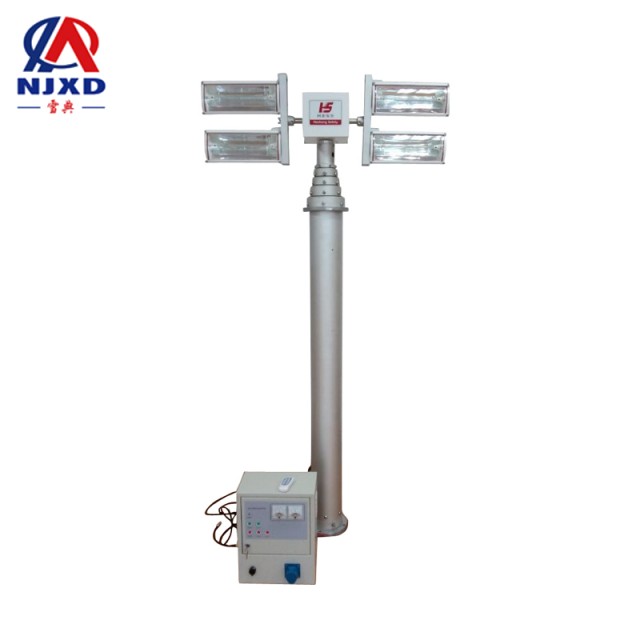NEWS
Standard value of light intensity lighting lifting lamp pole
Time:2021-03-10 View:

Calculation formula
Average illuminance (Eav) = light source total flux (N * ↓) * utilization coefficient (CU)* maintenance coefficient (MF) /Area (㎡)
(Suitable for indoor or stadium lighting calculation)
Utilization coefficient: generally, 0.4 is taken indoors and 0.3 is taken for sports.
Maintenance coefficient: generally 0.7~0.8
Example 1:
Indoor lighting: 4 × 5 meters room, use 3 × 36W 9 sets of grille lights,
Average illumination = light source total flux × CU × MF/area =(2500 × 3 × 9)× 0.4 × 0.8 ÷ 4 ÷ 5=1080 Lux
Conclusion: The average illuminance is over 1000Lux.
Example 2: stadium lighting: 20 × 40 m field, using POWRSPOT 1000W metal-halide lamp 60 sets,
Average illumination = light source total flux × CU × MF/area =(105000 × 60)× 0.3 × 0.8 ÷ 20 ÷ 40=1890 Lux
Conclusion: The average horizontal illuminance is above 1500 Lux.
Example of average illuminance design in an office:
Design conditions: office length 18.2 meters, width 10.8 meters, ceiling height 2.8 meters, desktop height 0.85 meters, utilization coefficient 0.4, maintenance coefficient 0.8, number of lamps 33 sets, what is the average illuminance in the office?
Lighting Solution: The lighting adopts DiNiT 2x 55W anti-glare daylight lamps, luminous flux 3000Lm, color temperature 3000K, color rendering Ra90 or more.
According to the formula: Eav = (33 sets X 6000Lm X 0.4X0.8) ÷(18.2 m X 10.8 m)
= 110880.00 ÷ 196.56 ㎡
= 564.10Lux
Note: lighting design must require accurate utilization coefficient, otherwise there will be a large deviation, which will affect the utilization coefficient. There are mainly the following factors: light distribution curve of lamps, light output ratio of lamps, indoor reflectivity, such as ceiling, wall, working desktop, etc., indoor index size.

Standard value
Definition
The average illuminance on the working surface or reference plane shall not be lower than this value. It is the average illuminance on the specified surface at the moment when the lighting device must be maintained, which is the illuminance required to ensure visual safety and Visual Efficacy during work.
Grading
Standard illuminance values are 0.5, 1, 2, 3, 5, 10, 15, 20, 30, 50, 75, 100, 150, 200, 300, 500, 750, 1000, 1500, 2000, 3000, 5000lx classification.
lx (Lux) is the unit of illumination.
The standard value of illuminance is graded to obviously feel the minimum change of illuminance in subjective effect, and the illuminance difference is about 1.5 times, this classification is generally consistent with the classification of CIE International Lighting Commission standard indoor workplace lighting S008/E--2001.
Lighting national standard data
The national standard of the People's Republic of China "standard for lighting design of buildings" GB 50034-2013 stipulates the general illuminance standard values of new, rebuilt and expanded residential, public and industrial buildings.
Room (place) reference plane and its height illuminance standard value (lx)
Living building living room (general activity) 0.75m horizontal plane 100
Residential building living room (writing and reading) 0.75m horizontal plane 300 should be mixed lighting
Living Building restaurant 0.75m table top 150
Library General reading room 0.75m horizontal plane 300
Office building ordinary office 0.75m horizontal plane 300
General supermarket business hall 0.75m horizontal plane 300
Hospital waiting room and registration Hall 0.75m horizontal plane 200
School classroom desk 300
School classroom blackboard surface 500
Common corridors and Mobile Area floors in public places 50
Escalator floor 50 in public places
Industrial Building machining rough machining 0.75m horizontal plane 200
Industrial building mechanical processing General processing tolerance ≥ 0.1mm 0.75m horizontal plane 300 should be added with local lighting
Industrial Building machining precision machining tolerance <0.1mm 0.75m horizontal plane 500 should add local lighting
When one or more of the following conditions are met, the illuminance of the working surface or the reference plane can be increased by one level according to the standard value.
1. Fine work places with high visual requirements, when the distance between eyes and recognition objects is greater than 500mm;
2. When the continuous tense visual work has adverse effects on visual organs for a long time;
3. Identify moving objects, requiring short recognition time and difficult recognition;
4. When visual operation has an important impact on operation safety;
5. When the brightness contrast of the recognition object is less than 0.3;
6. When the operation accuracy is required to be high and errors will cause great losses;
7. When the visual ability is lower than the normal ability;
8. High building grade and functional requirements.
When one or more of the following conditions are met, the illuminance of the working surface or the reference plane can be reduced by one level according to the standard value.
1. When working for a short time;
2. When the accuracy or speed of the operation is irrelevant;
3. When building grade and functional requirements are low.
In general, the design illuminance value can have a deviation of-10%-+ 10% compared with the illuminance standard value.

Related instruments
luminance meter
Luminance meter is a special equipment used to measure the intensity of light. In some specific environments, there are strict requirements on the illuminance of light. For example, manual inspection of drugs has strict requirements on the illuminance of light.
Related principles
Using germanium photovoltaic cell as probe, the current generated by photovoltaic cell is different due to different light intensity, and then this current is amplified by DC, then, through the digital-analog conversion circuit, the DC signal is turned into a digital signal that directly reflects the intensity of light.
